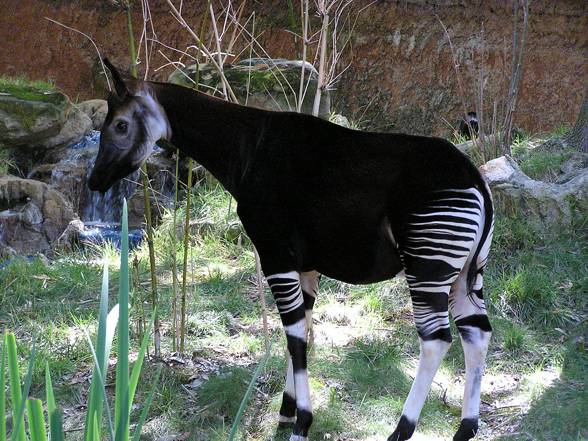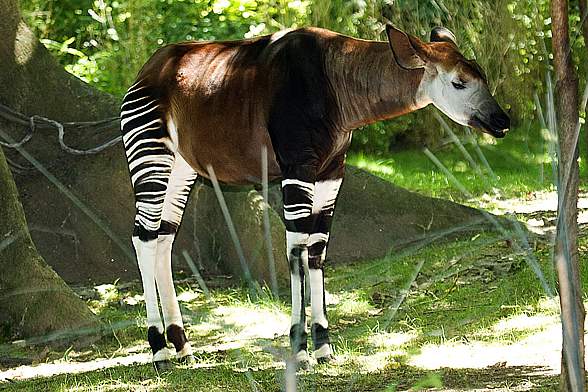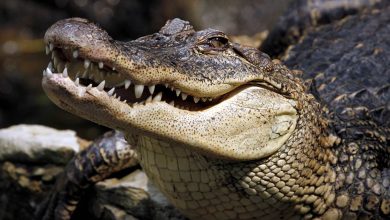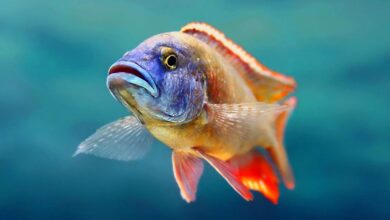Okapi (Okapia johnstoni) – the African unicorn
Okapi – a mysterious animal living in the Ituri tropical rainforests in the Democratic Republic of the Congo in Central Africa. It is the most closely related to the giraffe, but resembles a zebra. Because it’s very cautious, and, thus, difficult to capture, it has been called the African unicorn for many years. Few people genuinely believed that it had existed…
In the heart of the dense African rainforest, a creature exists that has long captivated the imagination of explorers, adventurers, and wildlife enthusiasts alike. With its striking appearance and elusive nature, the okapi, also known as the “African unicorn,” is one of the world’s most unique and enigmatic animals.
At first glance, the okapi appears to be a curious blend of features from several different animals: the striped hindquarters of a zebra, the long, prehensile tongue of a giraffe, and the physique of a horse. But this mysterious mammal is much more than the sum of its parts, and its peculiar appearance is just the tip of the iceberg when it comes to the fascinating world of the okapi.
In this article, we will take a deep dive into the world of the okapi, exploring everything from its physical characteristics and behavior to its cultural significance and conservation status. Join us as we embark on a journey of discovery through the rainforests of central Africa and uncover the secrets of this elusive and remarkable creature.
Classification
- Class: Mammalia
- Order: Artiodactyla
- Family: Giraffidae
- Genus: Okapia
- Species: Okapia johnstoni

Occurrence
The okapi occurs only on a small jungle territory in Central Africa. It inhabits the Ituri forests in the northeast of the Democratic Republic of the Congo.
Natural environment
The okapi prefers the altitudes ranging from 500 to 1000 meters above the sea level the most. However, it can be sometimes found in higher areas, especially in mountainous eastern parts of rainforests.
Because of a very high level of precipitation in the areas of distribution, the okapi’s coat is very oily so that it doesn’t absorbs water. Therefore, the coat is beautifully silky and shiny.
The range of distribution is bordered by natural conditions: mountains in the east, swamps in the southern-east, muddy forests in the west, and savannah in the north.
The okapi can be found primarily in the Epul and Wamba areas, and in the Okapi Wildlife Reserve (French: Parc National de la Ocapi) in the Ituri Forest (French: La forêt équatoriale de l’Ituri).

History
The history of the okapi is quite amazing and deserves some attention. Although this animal was probably well-known to ancient Egyptians, which can be proved by drawings of the okapi from that period, Europeans discovered the okapi only in 1901.
For many years, people from Europe who had come to Africa heard about a mysterious animal, but they had never seen it. Therefore, the okapi was called the African unicorn.
Only a British governor of Uganda – sir Henry Johnston – managed to document the existence of the okapi. It was possible thanks to the goodwill of natives who showed him traces of this animal. The man was able to obtain pieces of the animal’s skin and its skull. On its basis, the okapi was correctly classed to the relatives of the giraffe.

Characteristic features
The okapi has a reddish, dark back. Horizontal stripes on their fore and hind legs are their characteristic feature which makes them resemble a zebra from a distance. Such coloration helps the young follow their mother through a dense rainforest, but also serves as camouflage.
Similarly to giraffes, okapis have long legs and a robust body, but their necks are definitely shorter.
What differentiates the okapi from other animals is its uniquely long, bluish-gray tongue, that can be even 35 cm (14 in) long. This enables the animal to clean its eyelids and ears with it – both inside and outside. Males have short bumps covered with skin that resemble horns on their heads, called ossicones. Big ears and great hearing helps the okapi detect a predator from a distance.

Diet
The okapi is herbivorous, so it feeds on leaves, buds, grass, ferns, fruit and fungi.
Many plants eaten by the okapi are poisonous for human.
Reproduction
Okapis pair only during the mating season. Their mating behaviors include licking and rubbing on each other.
Gestation lasts about 14-15 months (420-450 days), and only one calf is born – always during the wet season. The calf weighs about 16 kg (35 lb) and stands to 80 cm (31 in) tall at the shoulder.
The young okapi leaves its birth place after two months. Only then, it is ready to escape a predator. The okapi’s lifespan is about 15 years.

Lifestyle
The okapi is considered to be diurnal, but photos taken recently may deny such a thesis. An individual that was eating leaves at 2.33 a.m. was captured in the photos – it means that the okapi can be active also at night.
However, it is certain that the okapi is solitary and socializes only in order to reproduce. The mother and her calf are the only exception. There are 0.6 animals per square kilometer (0.6 square mile) on average.
The okapi likes quiet and peace. Therefore, because of the limited home range and the development of human settlements, there is a problem with the decreasing population of the okapi.

Communication
Okapis have several ways to mark their territory. They use mostly urine and tar-like substance produced by scent glands. Males protect their territories but they let females cross them in order to get food.
Okapis in the wild
Although the okapi wasn’t classed as an endangered animal, because of its reduced habitat, the okapi population has been constantly decreasing. It is estimated that there are from 10 to 20 thousand individuals in the world.

Okapis in captivity
An okapi is certainly a unique attraction in every zoo, especially, if you take the difficulty in keeping it in captivity into account.
In 2011, there were only 155 okapis in zoos around the world. Most of them were in North American and European zoos, two individuals in the Republic of South Africa, and 7 okapis in Japan.
When they were discovered by Europeans, every zoo wanted to have them right away. However, first transport attempts failed and were associated with high level of mortality – mostly because of rigors of travel and stress. The first alive okapi arrived in Europe in 1918, so only 17 years after the discovery.

Detailed information / size
Okapi (Okapia johnstoni)
- Body length from the head to the tail base: 1,9 to 2,5 m (6.2 to 8.2 ft)
- Height at shoulders: from 1.5 to 2 m (4.9 to 6.5 ft)
- Tail length: from 30 to 42 cm (12 to 16 in)
- Weight: from 200 to 350 kg (441 to 772 lb)
- Lifespan: about 15 years
Okapi – interesting facts
- The okapi was put under protection already after 31 years after it was discovered by Europeans – in 1932.
- The okapi was the symbol of the defunct International Association for Cryptozoology.
- First living okapis were brought to Europe only in 1918 – after 17 years after they were discovered.
- The okapi’s tongue reaches 35 cm (14 in) of length. The animal can clean its eyelids and ears with it.

The first encounter of Europeans with the okapi
As the European explorers hacked their way through the dense, steamy jungle of central Africa, they could scarcely believe their eyes. Before them stood an animal unlike any they had ever seen before – a creature with the build of a horse, the stripes of a zebra, and the neck of a giraffe. Its eyes were large and curious, and its long, flexible tongue flickered out to taste the air.
The explorers, who had braved many dangers on their journey through the wilds of Africa, were struck dumb by the sight of this remarkable creature. They watched in awe as it moved through the undergrowth, its slender legs stepping delicately over fallen branches and rotting leaves.
One of the explorers, a grizzled veteran of many expeditions, was the first to speak. “What in the name of all that’s holy is that?” he whispered, staring at the strange animal with a mixture of wonder and suspicion.
“I don’t know,” replied his companion, a younger man with a thirst for adventure. “But I’m going to find out.”
With that, he stepped forward, his hand outstretched in a gesture of peace. The okapi, sensing no threat, approached him cautiously, its nostrils flaring. The young explorer reached out and touched its velvety nose, and a look of amazement crossed his face.
“It’s like nothing I’ve ever felt before,” he murmured, stroking the okapi’s muzzle. “Soft, and warm, and alive.“
The other explorers, seeing that the animal was not hostile, gathered around, staring in disbelief at the strange creature before them. They took notes, made sketches, and tried to capture the okapi’s image on film, though their equipment was no match for the speed and agility of the animal.
For days they followed the okapi, marveling at its grace and beauty. They saw it drink from clear, bubbling streams, and watched as it browsed on the tender shoots of the jungle’s many trees. And when they finally returned to civilization, they brought with them tales of the amazing creature they had encountered, a creature that seemed to belong to another world entirely.

Recommended
- African animals
- African lion
- Zebra
- Zebroid
- Elephants
- Giraffe
- Grizzly bear
- Largest eagles Top10
- Largest birds of prey Top10
- Animals & dinosaurs records
- The fastest animals – Top 100
- The fastest birds – Top 10


















